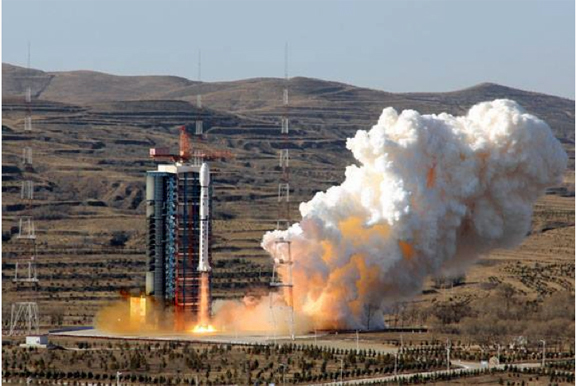
The Chinese launch of the Brazilian CBERS-4 satellite.
Photo courtesy of Xinhau.
[SatNews] China launched the CBERS-4 satellite, jointly developed with Brazil, on Sunday from the Taiyuan base via a Long March-4B rocket—this was the 200th flight since April 24, 1970, for the Long March rocket family.
The rocket blasted off at 11:26 a.m. and lifted the Earth resource satellite into its scheduled orbit, according to the Taiyuan satellite launch center in north China's Shanxi province. CBERS-4 is one of the satellites of the Chinese-Brazilian Earth Resource Satellite (CBERS) program, which was started in 1988. Such satellites are used in the monitoring, planning and management of land, forestry, water conservancy, environmental protection and agriculture.
China started work on carrier rockets in 1956. Long March rockets have since become the main carriers for satellites and spacecraft, taking more than 250 into space, including the Shenzhou unmanned and manned spaceships, China's first space lab Tiangong-1, and lunar orbiters.Lei Fanpei, chairman of the China Aerospace Science and Technology Corporation (CASC), the main contractor for the space program, told Xinhua that the Long March rockets will make at least another 100 launches in the next seven years. The rockets are designed and manufactured by the China Academy of Launch Vehicle Technology, a CASC subsidiary.
Carrier rockets made by the United States, Russia and Europe are capable of lifting at least a 20 ton payload into Low Earth Orbit (LEO), while China's current rockets can only deliver less than half of that weight. The next-generation rockets include the large Long March-5 and the smaller Long March-7. Using non-polluting propellant, the Long March-5 should make its maiden flight within the next two years, probably at a new launch site in South China's Hainan Province. The Long March-5 will have a 25 ton payload capacity to LEO, or 14 tons to geostationary transfer orbit, about twice current capacity, and could be a serious competitor to the U.S. Delta-4H. The Long March-7 will carry up to 13.5 tons to LEOm or 5.5 tons to sun-synchronous orbit at a height of 700km and will carry cargo craft for the planned Chinese space station. The maiden flight of the Long March-7 should be next year. Chinese scientists are also working hard on a powerful heavy carrier rocket for a manned moon landing.